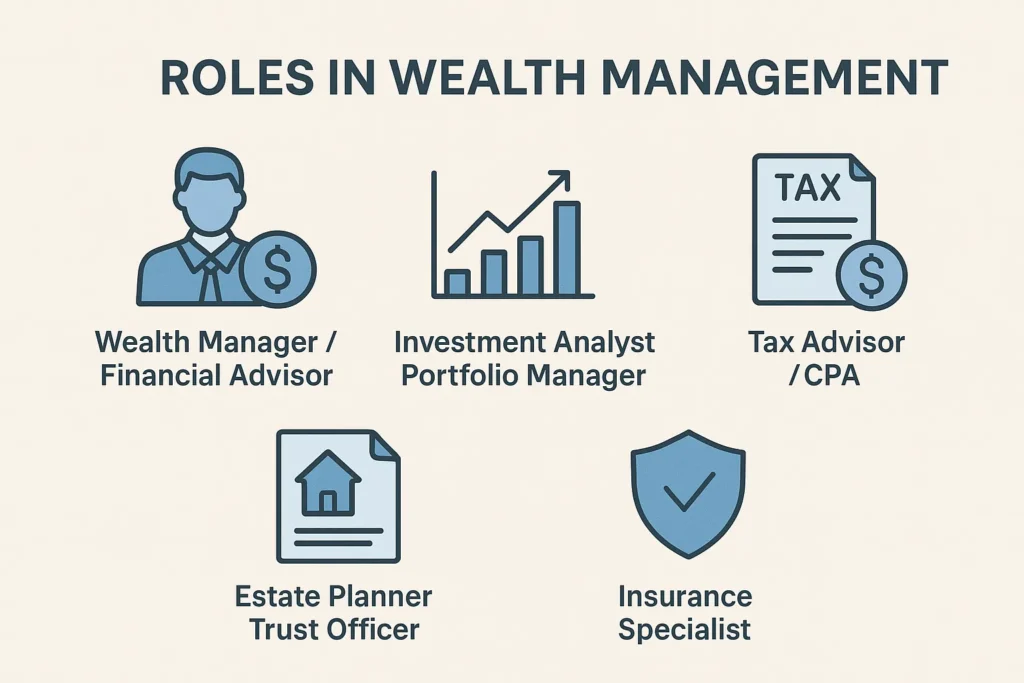
Executive Summary
Wealth management is a comprehensive financial service designed to help individuals and families grow, protect, and transfer their wealth. It combines investment management, financial planning, tax strategies, estate planning, and risk management into a coordinated approach tailored to each client’s goals.
Unlike traditional investment services that focus primarily on asset growth, wealth management emphasizes long-term financial well-being, integrating multiple aspects of personal finance to ensure sustainable wealth accumulation and preservation.
This guide explores the fundamentals of wealth management, its principles, strategies, services, benefits, challenges, and the role of modern technology in shaping wealth advisory practices.
Table of Content
Introduction
In a world of increasingly complex financial markets and life circumstances, wealth management has emerged as a vital service for high-net-worth individuals, families, and businesses. Wealth management is not just about increasing monetary value—it’s about creating a holistic plan that aligns financial decisions with personal values, life goals, and legacy planning.
By coordinating investment strategies with tax efficiency, retirement planning, estate considerations, and risk management, wealth managers help clients achieve financial security and make informed decisions in uncertain economic environments.
The Origins of Wealth Management
Wealth management, as a formal profession, has evolved over centuries:
- Ancient Wealth Advisory – In early civilizations, wealthy families employed advisors to manage estates, land, and valuables.
- Modern Banking Era – Private banks emerged in the 17th and 18th centuries, offering investment and financial planning services to affluent clients.
- 20th Century Expansion – Financial advisors began integrating tax planning, insurance, and retirement solutions into their services.
- Contemporary Wealth Management – Today, wealth management combines personalized financial planning, investment advisory, legal advice, and digital tools to serve a wide range of clients.
Core Principles of Wealth Management
Wealth management operates on several key principles:
- Holistic Approach – Combines multiple financial disciplines to address all aspects of a client’s financial life.
- Customization – Tailors strategies to an individual’s financial situation, goals, risk tolerance, and life stage.
- Risk Management – Balances potential returns with risk exposure across investments, insurance, and other financial instruments.
- Long-Term Perspective – Focuses on sustainable wealth growth, retirement security, and legacy planning.
- Transparency and Trust – Establishes a clear, ethical, and open relationship between clients and advisors.
Related Articles to Explore
Wealth management intersects with financial, asset, and risk management. These guides provide further insights:
- What Is Asset Management? – Learn how effectively managing assets supports wealth growth and protection.
- What Is Risk Management? – Discover how identifying and mitigating financial risks ensures long-term stability.
- What Is Business Management? – See how strategic planning helps integrate financial and wealth management practices.
- How to Become a Business Analyst – Explore how analytical skills help manage wealth and make data-driven financial decisions.
- What Is Data Management? – Understand how organizing financial data improves portfolio management and reporting.
Components of Wealth Management
Wealth management typically includes several interconnected services:

1. Investment Management
- Developing an investment portfolio tailored to client objectives.
- Strategies include diversification, asset allocation, and portfolio rebalancing.
- Monitoring performance to optimize returns and mitigate risks.
2. Financial Planning
- Comprehensive planning for short-term and long-term goals.
- Includes budgeting, cash flow analysis, and retirement planning.
- Aligns financial decisions with lifestyle aspirations and family needs.
3. Tax Planning
- Strategies to reduce tax liabilities through legal means.
- Incorporates income tax optimization, tax-efficient investment structures, and estate tax planning.
4. Estate Planning
- Preparing for wealth transfer to heirs or beneficiaries.
- Includes wills, trusts, charitable giving strategies, and succession planning.
5. Risk Management and Insurance
- Protecting wealth through appropriate insurance coverage.
- Managing financial exposure to life, health, property, and liability risks.
6. Retirement Planning
- Ensuring financial security during retirement.
- Includes pension plans, retirement accounts, and withdrawal strategies.
7. Philanthropy and Charitable Planning
- Supporting clients’ philanthropic goals through structured giving strategies.
- Tax-efficient methods include donor-advised funds, charitable trusts, and endowments.
Types of Wealth Management Services
1. Private Wealth Management
- Targets high-net-worth individuals (HNWIs) and ultra-high-net-worth individuals (UHNWIs).
- Services are highly personalized and often include concierge financial support.
2. Retail Wealth Management
- Designed for middle-income clients with smaller investment portfolios.
- Focuses on goal-based financial planning and standardized investment products.
3. Family Office Services
- Provides comprehensive financial and administrative services for wealthy families.
- Includes investment management, estate planning, tax compliance, and lifestyle management.
4. Digital Wealth Management / Robo-Advisors
- Uses automated, algorithm-driven platforms to provide financial advice and investment management.
- Offers lower fees and accessibility for clients with smaller portfolios.
The Wealth Management Process
Wealth management follows a structured process to ensure alignment with client goals:
1. Discovery and Goal Setting
- Understanding client financial situation, life objectives, risk appetite, and priorities.
2. Analysis and Strategy Development
- Evaluating current assets, liabilities, and financial opportunities.
- Designing an integrated financial strategy.
3. Portfolio Construction
- Selecting investment products based on risk tolerance and goals.
- Balancing asset allocation to optimize returns and minimize risk.
4. Implementation
- Executing the wealth plan, including investments, insurance, and estate planning.
5. Monitoring and Reporting
- Tracking performance and making adjustments as needed.
- Regular reviews ensure alignment with changing market conditions and client circumstances.
6. Review and Rebalancing
- Adjusting strategies based on life events, economic changes, or financial goals.
Roles in Wealth Management
Wealth management relies on specialized professionals:

- Wealth Manager / Financial Advisor – Designs and oversees the comprehensive financial strategy.
- Investment Analyst / Portfolio Manager – Manages investment portfolios, conducts market research, and recommends strategies.
- Tax Advisor / CPA – Provides tax planning and compliance services.
- Estate Planner / Trust Officer – Ensures effective wealth transfer and legal compliance.
- Insurance Specialist – Evaluates and structures insurance coverage for risk management.
Wealth Management Strategies
Successful wealth management involves a combination of strategies:
- Asset Allocation – Diversifying investments across asset classes such as equities, bonds, real estate, and alternative investments.
- Risk Mitigation – Hedging against market volatility, inflation, and currency risks.
- Tax Efficiency – Structuring investments and withdrawals to minimize tax exposure.
- Liquidity Management – Ensuring access to cash for emergencies or opportunities.
- Legacy Planning – Establishing wills, trusts, and charitable foundations to secure the client’s desired legacy.
Wealth Management Tools and Technology
Modern wealth management leverages technology for efficiency and insights:
- Portfolio Management Software: Morningstar, BlackRock Aladdin, eMoney Advisor.
- Financial Planning Platforms: RightCapital, MoneyGuidePro, Advizr.
- Robo-Advisors: Betterment, Wealthfront, Vanguard Digital Advisor.
- Data Analytics Tools: Power BI, Tableau for performance monitoring and risk analysis.
- Secure Communication Platforms: Encrypted portals for client-advisor interaction.
Benefits of Wealth Management
- Comprehensive Financial Oversight – Consolidates multiple financial services into a single, coordinated plan.
- Tailored Strategies – Customized solutions based on individual goals and risk tolerance.
- Enhanced Risk Management – Protects wealth from market volatility, inflation, and unforeseen life events.
- Tax Optimization – Reduces tax burdens through strategic planning.
- Long-Term Growth – Focused on sustainable wealth accumulation and preservation.
- Legacy Planning – Ensures wealth transfer according to client wishes.
- Peace of Mind – Professional guidance reduces stress and uncertainty in financial decision-making.
Challenges in Wealth Management

- Complex Regulations – Compliance with tax laws, securities regulations, and international financial laws can be complex.
- Market Volatility – Economic shifts can impact portfolio performance.
- High Costs for Personalized Services – Private wealth management services may involve significant fees.
- Client Behavior Risks – Emotional decisions can disrupt long-term plans.
- Technological Integration – Ensuring digital tools work seamlessly with traditional advisory processes.
Wealth Management Metrics and KPIs
Monitoring performance is critical to wealth management:
- Portfolio Performance vs. Benchmark – Evaluates investment success.
- Net Worth Growth – Measures overall increase in wealth over time.
- Risk-Adjusted Returns – Balances returns with volatility and risk exposure.
- Liquidity Ratios – Measures availability of cash or liquid assets.
- Estate Planning Compliance – Ensures wills, trusts, and succession plans are up to date.
- Client Satisfaction – Assessed through surveys and retention rates.
Real-World Applications of Wealth Management
- High-Net-Worth Individuals – Optimizing investments, tax planning, and succession strategies.
- Family Offices – Managing intergenerational wealth and philanthropy.
- Corporate Executives – Planning stock options, retirement, and estate transfers.
- Entrepreneurs – Preserving liquidity while investing in business growth opportunities.
- Retirees – Ensuring sustainable income, risk management, and estate planning.
Common Misconceptions
- Wealth Management is Only for the Rich – While often associated with HNWIs, scaled services are available for broader demographics.
- It’s Just Investment Advice – Wealth management integrates multiple financial services, including tax, estate, insurance, and retirement planning.
- Guaranteed Returns – Professional advice optimizes growth but cannot eliminate market risk.
- It’s a One-Time Service – Wealth management is an ongoing process requiring periodic review and adjustments.
Steps to Implement Wealth Management

- Assess Financial Situation – Review assets, liabilities, income, and expenses.
- Define Goals – Short-term, medium-term, and long-term financial objectives.
- Choose a Wealth Manager or Platform – Decide between personalized advisory or digital tools.
- Develop an Integrated Strategy – Incorporate investments, tax, estate, insurance, and retirement planning.
- Implement Recommendations – Execute investment plans, insurance policies, and estate documents.
- Monitor and Adjust – Periodically review performance and adjust strategies based on changing circumstances.
Future of Wealth Management
Wealth management is evolving due to technology, demographics, and market dynamics:
- Digital Transformation – Robo-advisors and AI-driven insights provide accessible and efficient solutions.
- Sustainable Investing – ESG-focused strategies are increasingly popular among clients.
- Globalization – Advisors manage international assets, investments, and tax obligations.
- Data Analytics – Advanced analytics and predictive modeling enhance portfolio performance and risk management.
- Intergenerational Wealth Transfer – Planning for the next generation is becoming a central focus.
Conclusion
Wealth management is a holistic, dynamic approach to financial planning that helps individuals, families, and businesses achieve their financial goals. By integrating investment management, tax strategies, estate planning, risk management, and retirement planning, wealth managers provide tailored solutions that promote sustainable growth, security, and legacy preservation.
As financial markets become more complex and life goals more personalized, effective wealth management ensures clients can navigate challenges, seize opportunities, and secure financial well-being across generations.


